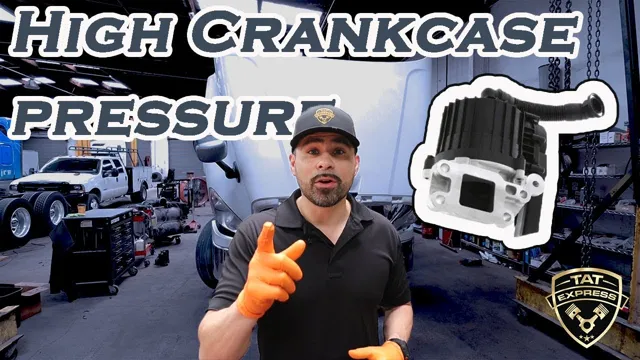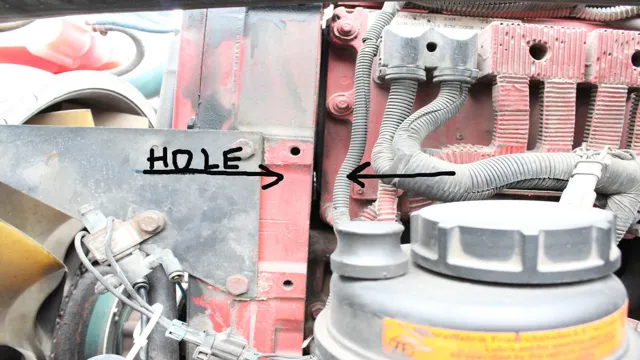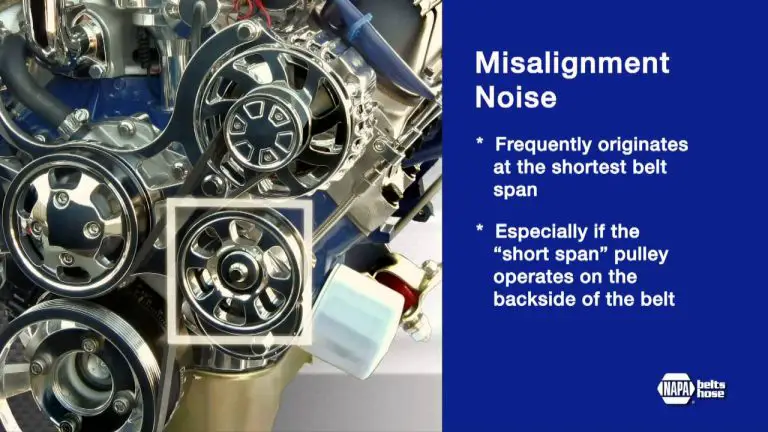Get Back on Track: A Comprehensive Guide on How to Fix High Crankcase Pressure
Do you find yourself constantly topping off your oil and noticing a significant buildup of pressure in your engine? If so, you may be experiencing high crankcase pressure. This issue can lead to engine damage, decreased fuel efficiency, and even complete engine failure. But don’t worry, with our complete guide, you’ll be able to diagnose and fix high crankcase pressure in no time.
High crankcase pressure occurs when gases produced during normal engine operation, such as combustion byproducts and blow-by gases, build up in the crankcase instead of being vented out properly. This can be caused by a variety of factors, such as a clogged PCV valve, worn piston rings, or even a damaged head gasket. The first step in fixing high crankcase pressure is identifying the root cause of the issue.
This can be done through a simple pressure test or by inspecting various engine components. Once you’ve identified the source of the problem, you can then take the necessary steps to repair or replace the damaged parts. It’s important to address high crankcase pressure as soon as possible to avoid any further damage to your engine.
Fortunately, with our guide, you’ll be able to fix this issue yourself and save yourself a trip to the mechanic. So what are you waiting for? Let’s get started and get your engine running smoothly again!
Understanding Crankcase Pressure
Excessive crankcase pressure can lead to a number of issues such as oil leaks, engine misfires, and failure of seals and gaskets. High levels of crankcase pressure are usually caused by a blockage in the PCV (positive crankcase ventilation) system or the failure of the PCV valve. This results in a build-up of pressure within the crankcase, causing oil to leak past seals and gaskets.
To fix high crankcase pressure, start by checking the PCV valve for signs of wear or damage, and replace it if necessary. If the valve appears to be in good condition, check the entire PCV system for blockages or leaks. Make sure the hoses are securely connected and lubricated, and replace any that are worn or damaged.
Proper maintenance of the PCV system is crucial to avoid issues caused by excessive crankcase pressure.
What is Crankcase Pressure?
Crankcase pressure is a term used to describe the pressure that builds up within the engine’s crankcase, which houses the engine’s crankshaft and other key components. This pressure is a natural byproduct of the combustion process, as gases and other byproducts are created and need to be expelled. However, if the pressure within the crankcase becomes too high, it can cause a range of problems.
These may include oil leaks, engine damage, and reduced performance. Understanding crankcase pressure is essential for maintaining your engine’s health, especially if you own a high-performance vehicle or regularly use your vehicle for towing or other demanding tasks. By monitoring this pressure and taking steps to reduce it as needed, you can help ensure that your engine runs smoothly and reliably for years to come.
What Causes Excessive Crankcase Pressure
Excessive crankcase pressure can be a sign of a few different issues within your engine. Here are some of the common causes:
- Piston Ring Blow-by: This is the most frequent culprit. Piston rings are supposed to seal the combustion chamber tightly, preventing pressure from leaking into the crankcase. Worn or damaged piston rings can allow combustion gasses to bypass them, causing the crankcase to become pressurized.
- Stuck or Faulty PCV Valve (Positive Crankcase Ventilation Valve): The PCV valve is responsible for regulating the pressure within the crankcase by allowing controlled amounts of crankcase gases to be routed back into the intake system to be burned. A stuck closed PCV valve can trap these gases, leading to a buildup of pressure. Conversely, a stuck open PCV valve might allow excessive amounts of unfiltered crankcase gases into the intake, causing performance issues.
- Blocked Crankcase Breather System: Some engines have an alternative system to the PCV valve, or in addition to it, which uses a crankcase breather filter. If this filter or breather passage becomes clogged, it can prevent proper ventilation and contribute to crankcase pressure buildup.
- Worn Valve Guides or Seals: Valve guides and seals help ensure proper movement and sealing of the engine valves. Worn guides or damaged seals can allow combustion gasses to leak past the valves and into the crankcase, causing pressure to rise.
- Turbocharger Issues (in turbocharged engines): A malfunctioning turbocharger, particularly a leaking oil seal, can allow compressed air from the intake side to leak into the crankcase, leading to increased pressure.
Symptoms of Excessive Crankcase Pressure:
- Oil leaks or seepage from gaskets or seals due to the excess pressure.
- Dipstick or oil filler cap blowing out or feeling pressurized when removed.
- Engine oil turning foamy or milky due to excessive crankcase gasses mixing with the oil.
- Decreased engine performance due to various factors like oil contamination or disrupted air-fuel mixture.
Diagnosing the Cause:
If you suspect excessive crankcase pressure in your engine, it’s crucial to seek professional help for proper diagnosis. A mechanic can perform tests like a compression test or crankcase pressure test to identify the root cause.
Here are some additional points to remember:
- Ignoring excessive crankcase pressure can lead to further engine damage, so it’s important to address the issue promptly.
- The repairs needed will depend on the specific cause. It might involve replacing worn piston rings, a faulty PCV valve, or a malfunctioning turbocharger component.
By understanding the causes and symptoms of excessive crankcase pressure, you can be more aware of potential engine problems and take steps to address them promptly.

What are the causes of stuck piston rings and how can this issue be resolved?
The causes of stuck piston rings can stem from various factors such as using low-quality oil or fuel, not following proper oil change intervals, engine overheating, or driving with a cold engine. When faced with this issue, it is crucial to decarbonize the engine to restore the mobility of the piston rings and ensure the engine operates smoothly. To effectively remove deposits in gasoline and diesel engines causing stuck piston rings, utilizing specialized products like XADO Anticarbon is recommended. These products are designed to swiftly eliminate the sticking of piston rings without the need for engine disassembly. By introducing the composition directly into the engine cylinders through the spark plug holes (or fuel injector and glow plug holes for diesel engines), the mobility of the piston rings can be restored, allowing for the engine to function properly.
What are the potential causes of increased pressure of crankcase gases?
Increased pressure of crankcase gases can be attributed to various factors. Contamination of the crankcase ventilation system, wear of the cylinder-piston group, stuck piston rings, and unpressurized valves are among the potential causes. When these factors are present, gases may bypass the piston rings, causing a condition known as ‘blow-by.’ This blow-by phenomenon results in a buildup of pressure that forces oil into the ventilation system manifold, leading to smoke leaking through the oil level gauge.
What are the malfunctions of the crankcase ventilation system and their consequences?
Malfunctions in the crankcase ventilation system can lead to significant consequences for the engine’s performance and longevity. One common issue is with the positive crankcase ventilation (PCV) valve, which plays a critical role in regulating gas pressure within the engine. When the PCV valve becomes clogged with oil deposits, it may get stuck in either the open or closed position. If the PCV valve is stuck open, the continuous flow of crankcase gases into the intake line can disrupt the fuel mixture, causing the engine to run lean and operate erratically. On the other hand, a closed PCV valve prevents proper circulation of gases, leading to a buildup of pressure inside the engine. This increased pressure can strain engine seals, like valve stem seals and crankshaft seals, potentially causing leaks and a higher rate of oil consumption due to burning. Overall, malfunctions in the crankcase ventilation system can lead to fuel inefficiency, poor engine performance, and potential damage to critical engine components.
How can one determine if exhaust gases are accumulating in the engine crankcase when the crankcase ventilation system is closed?
To determine if exhaust gases are accumulating in the engine crankcase when the crankcase ventilation system is closed, there are specific signs you can look for. One method involves observing the behavior of smoke when the engine is warm and running. By unscrewing the oil drain cap and monitoring the smoke coming from the oil filler neck, you can assess the crankcase gas pressure. If only a small amount of smoke is emitted, the crankcase gas pressure is likely normal. However, if the smoke resembles that of a tailpipe and you notice engine oil splashing out, it indicates high crankcase gas pressure, possibly due to exhaust gases accumulating. In such instances, it is important to take steps to identify and address the underlying cause promptly.
Why is it Important to Fix High Crankcase Pressure?
If you’ve ever heard strange noises coming from your car’s engine or noticed a decrease in power and acceleration, it could be due to high crankcase pressure. Crankcase pressure refers to the pressure that builds up inside the engine’s crankcase, which is the housing that encloses the crankshaft in an internal combustion engine. High crankcase pressure can cause oil leaks, damage to engine components, and decreased fuel efficiency.
To prevent these issues, it’s crucial to fix high crankcase pressure as soon as possible. By doing so, you can ensure your engine runs smoothly and avoid costly repairs in the future. So, if you suspect your engine has high crankcase pressure, it’s best to have it checked by a professional mechanic who can diagnose and fix the issue before it causes further damage.
Identifying High Crankcase Pressure
If you’re experiencing high crankcase pressure in your vehicle, you may notice a number of unpleasant symptoms like oil leaks and seals breaking down. To fix this issue, it’s essential to first identify the root cause. One of the most common culprits is a clogged crankcase ventilation system.
This can cause pressure to build up in the engine, leading to oil leaks and other problems. To fix this, you may need to clean or replace your PCV valve or replace any blocked hoses in the system. It’s also important to check your engine oil level and make sure it’s not overfilled.
Other possible causes of high crankcase pressure include worn piston rings, blocked air filters, or a damaged head gasket. Whatever the cause may be, addressing the issue early on is key to avoiding more serious engine damage down the road.
Symptoms of High Crankcase Pressure
Identifying high crankcase pressure can be essential to prevent potential damage to your vehicle’s engine. There are certain symptoms to look out for that indicate high crankcase pressure. Firstly, you may notice an increase in oil consumption due to oil being forced out of the engine.
Secondly, you may detect excessive smoke coming out of the tailpipe due to oil being burned in the engine. The oil consumption and smoke may further lead to the clogging of the engine’s air and oil filters, which may further negatively impact the engine’s performance. In severe cases, high crankcase pressure may cause the engine to emit a knocking sound or, in rare cases, cause the engine to fail completely.
Therefore, it’s important to pay attention to these symptoms and take immediate action when detecting them. Regular maintenance and inspections can help to prevent high crankcase pressure and other potential engine problems.
Causes of High Crankcase Pressure
When it comes to identifying high crankcase pressure, there are a few key signs you should keep an eye out for. One of the most common is an increase in air or oil leaks, which can happen when pressure builds up inside the system and causes components to break or warp. You may also notice that your engine is running hotter than usual or that there is more smoke coming from the exhaust pipe.
Another telltale sign is a loss of power or reduced efficiency when you’re driving. All of these symptoms can be traced back to a variety of causes, including worn or damaged piston rings, a blocked PCV valve, or a faulty turbocharger. If you suspect that your engine is experiencing high crankcase pressure, it’s important to address the issue right away to prevent further damage and ensure long-term reliability.
Fixing High Crankcase Pressure
If you’ve noticed high crankcase pressure in your engine, there are a few steps you can take to fix the issue. First, check the PCV valve and ensure it’s working properly. If it’s clogged or stuck closed, it can lead to increased pressure.
Additionally, check for any leaks in the crankcase ventilation system, such as loose hoses or damaged gaskets. These can cause air to bypass the PCV valve and increase pressure. Another possible cause is worn piston rings, which allow air to escape from the combustion chambers and enter the crankcase.
In this case, an engine rebuild may be necessary. By addressing the root cause of high crankcase pressure, you can ensure your engine runs smoothly and efficiently.
Step 1: Check PCV Valve
One of the reasons for high crankcase pressure can be a faulty PCV (positive crankcase ventilation) valve. The PCV valve regulates the flow of gases within the engine’s crankcase and prevents any pressure build-up. However, if the valve is blocked or clogged with dirt and debris, it can cause excessive pressure.
To check whether the PCV valve is functioning correctly, start by removing it from your car’s engine and shaking it. If you hear a rattling, it’s a sign the valve is working correctly. Another way to check if the PCV valve is faulty is to blow through the end where it connects to the engine.
If you can’t blow through it, or it’s tough to blow, then it’s time to replace the valve. In conclusion, a faulty PCV valve is one of the main causes of high crankcase pressure, and checking it is the first step in fixing the issue.
Step 2: Check Engine Oil Level
“High Crankcase Pressure” After identifying high crankcase pressure in your vehicle, the first step is to check the engine oil level. High crankcase pressure can cause oil to leak from the engine, which can lead to significant damage if not addressed promptly. Start by turning off your vehicle and letting it cool down for at least a few minutes.
Then, locate the dipstick and pull it out of the engine. Wipe the dipstick clean with a cloth, reinsert it, and pull it out again to check the oil level. If the oil level is below the recommended level, you’ll need to add more oil.
However, if the oil level is too high, this could also be a sign of high crankcase pressure. In that case, it’s recommended to take your vehicle to a professional mechanic to diagnose and repair the issue. Regularly checking your engine oil level can help catch high crankcase pressure early, preventing further damage and costly repairs in the future.
Step 3: Replace Head Gasket (if needed)
If you’ve followed the first two steps of diagnosing and fixing a high crankcase pressure issue in your engine, and you’re still having problems, it might be time to replace the head gasket. The head gasket seals the engine block and cylinder head, and if it’s damaged, it can cause compression leaks and allow gases to escape into the crankcase. This can lead to high pressure buildup and cause the symptoms you’re experiencing.
If you suspect the head gasket is the problem, it’s important to have it replaced as soon as possible to prevent further damage to your engine. A professional mechanic will be able to assess the condition of your head gasket and determine the best course of action for fixing the issue. By replacing the head gasket, you can ensure your engine runs smoothly and efficiently, without the worry of high crankcase pressure causing damage.
Step 4: Replace Piston Rings (if needed)
If you’re experiencing high crankcase pressure, there’s a chance that your piston rings may need to be replaced. Piston rings are responsible for sealing the combustion chamber and preventing oil from leaking into the combustion chamber. When the piston rings wear down or break, oil can enter the combustion chamber and cause high pressure in the crankcase.
This can also lead to decreased engine performance and increased oil consumption. Replacing piston rings can be a complicated process that requires the engine to be disassembled, so it’s best to have a professional mechanic handle the job. However, by replacing the piston rings, you can ensure that your engine is running efficiently and prevent any further damage.
Preventing High Crankcase Pressure
Having high crankcase pressure can be a real headache, causing all kinds of problems for your vehicle. However, there are several ways of preventing this from happening in the first place. One of the most effective ways is to ensure that your engine’s PCV (Positive Crankcase Ventilation) valve is clean and functioning correctly.
This valve is responsible for regulating the pressure inside the engine, allowing harmful gases to be released safely. If the PCV valve becomes clogged or fails, it can cause high levels of pressure, leading to leaks, engine oil contamination, and even engine damage. Regular engine maintenance, including oil changes and inspection of the PCV valve, is a crucial step in preventing high crankcase pressure.
Additionally, keeping your engine at the correct oil level and improving ventilation through the engine can also help reduce pressure build-up. If you are experiencing high crankcase pressure, it’s essential to seek professional help before risking damage to your engine.
Regular Maintenance
Regular maintenance of your vehicle is crucial for its longevity and your safety on the road. One of the common problems that can occur if maintenance is neglected is high crankcase pressure. High crankcase pressure can cause oil leaks, decreased engine performance, and ultimately engine failure.
The main causes of high crankcase pressure are worn-out piston rings or faulty PCV valves. Regularly changing your oil, checking and replacing your PCV valve, and getting your engine inspected by a certified mechanic are all steps that can prevent high crankcase pressure from occurring. Just like how we need to take care of our bodies through regular check-ups with doctors, our vehicles also need consistent care to ensure they operate efficiently and safely.
Don’t wait until you hear strange noises or experience engine failure, prioritize regular maintenance to prevent issues like high crankcase pressure from happening.
Oil Changes
One of the key reasons for regular oil changes is to prevent high crankcase pressure, which can cause engine damage and decreased performance. As your engine runs, hot gases and combustion byproducts mix with the oil, causing it to break down and become acidic over time. This can lead to sludge buildup in the oil system, increasing pressure in the engine’s crankcase and putting stress on the seals and gaskets.
Regular oil changes help to remove this buildup and ensure that your oil is working properly to lubricate the engine and maintain optimal pressure. Think of getting an oil change like changing the air filter in your home- the longer you go without doing it, the harder your engine has to work, which can result in costly repairs down the road. So, be sure to keep up with recommended oil change intervals to keep your engine running smoothly and efficiently.
Conclusion
Fixing high crankcase pressure is a lot like fixing a fussy toddler. You need to discover the root of the problem, offer a gentle solution and patiently implement the fix. Whether it’s a faulty PCV valve or a clogged breather system, taking the time to properly diagnose and address the issue can save you from experiencing a tantrum-inducing breakdown on the road.
So, give your engine the care and attention it deserves, and you’ll have a purring little engine running smoothly in no time!”
FAQs
What causes high crankcase pressure?
High crankcase pressure is usually caused by worn out piston rings or faulty PCV valves.
How can I tell if my vehicle has high crankcase pressure?
Signs of high crankcase pressure include excessive oil consumption, white or blue smoke from the exhaust, and a rough idle.
Can high crankcase pressure damage my engine?
Yes, high crankcase pressure can cause serious engine damage if left unchecked. It can lead to oil leaks, blown gaskets, and even engine failure.
How do I fix high crankcase pressure?
The best way to fix high crankcase pressure is to identify and repair the root cause issue. This may involve replacing worn piston rings, cleaning or replacing the PCV valve, or addressing other engine problems. It’s best to consult with a trusted mechanic for proper diagnosis and repair.






